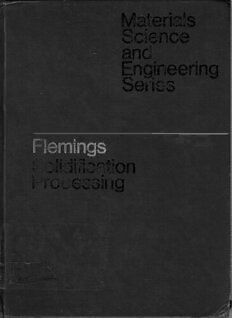Table Of ContentSOL~ICATlOr~
PROCESSING
TN
630
,f-53
McGRAW-HILL SERIES IN
MATERIALS SCIENCE AND ENGINEERING
Editorial Board
MICHAEL B. BEVER
M. E. SHANK
CHARLES A. WERT
ROBERT F. MEHL, Honorary Senior Advisory Editor
AVITZUR: Metal Forming: Processes and Analysis
AZAROFF: Introduction to Solids
BARRETTANDMASSALSKI:Structure of Metals
BLATT:Physics of Electronic Conduction in Solids
BRICK, GORDON,ANDPHILLIPS: Structure and Properties of Alloys
BUERGER:Contemporary Crystallography
BUERGER:Introduction to Crystal Geometry
DE HOFFANDRHINES: Quantitative Microscopy
DRAUGLIS,GRETZ, ANDJAFFEE:Molecular Processes on Solid Surfaces
ELLIOTT: Constitution of Binary Alloys, First Supplement
FLEMINGS:Solidification Processing
GILMAN:Micromechanics of Flow in Solids
GORDON: Principles of Phase Diagrams in Materials Systems
GUY: Introduction to Materials Science
HIRTH ANDLOTHE:Theory of Dislocations
KANNINEN,ADLER,ROSENFIELD,ANDJAFFEE:Inelastic Behavior of Solids
MILLS,ASCHER,ANDJAFFEE:Critical Phenomena in Alloys, Magnets, and Super-conductors
MURR: Electron Optical Applications in Materials Science
PAULANDWARSCHAUER:Solids under Pressure
ROSENFIELD,HAHN, BEMENT,ANDJAFFEE:Dislocation Dynamics
ROSENQVIST:Principles of Extractive Metallurgy
RUDMAN,STRINGER,ANDJAFFEE:Phase Stability in Metals and Alloys
SHEWMON:Diffusion in Solids
SHEWMON:Transformations in Metals
SHUNK: Constitution of Binary Alloys, Second Supplement
WERTANDTHOMSON:Physics of Solids
McGRAW-HILL
BOOK COMPANY
New York
St. Louis
San Francisco
Dusseldorf
Johannesburg
Kuala Lumpur
London
Mexico
Montreal
New Delhi
Panama
Rio de Janeiro
Singapore
Sydney
Toronto
MERTON C. FLEMINGS
Abex Professor of Metallurgy
Massachusetts Institute of Technology
Solidification
Processing
This book was set in Times Roman.
The editors were B. J. Clark and Michael Gardner;
the production supervisor was Joan M. Oppenheimer.
The drawings were done by John Cordes, J &R Technical Services, Inc.
The printer and binder was The Maple Press Company.
Library of Congress Cataloging in Publication Data
Flemings, Merton C 1929-
Solidification processing.
(McGraw-Hill series in materials science and
engineering)
Includes bibliographical references.
1. Solidification. 2. Alloys. I. Title.
TN690.F59 669'.9 73-4261
ISBN 0-07-021283-x
SOLIDIFICA nON
PROCESSING
Copyright © 1974by McGraw-HilI, Inc. All rights reserved.
Printed in the United States ofAmerica. No part of this publication may be reproduced,
stored in a retrieval system, or transmitted, in any form or by any means,
electronic, mechanical, photocopying, recording, or otherwise,.
without the prior written permission of the publisher.
567 89-MAMM-76 54321
CONTENTS
..
~~T~:J.>fJ~~:\"",1-
~- r.. ,. ''''
"
, ~OT clVr·.:...·H···.:~J~~1(!:J.;J;H.;J.~)fl~.r
Preface
IX
1 Heat Flow in Solidification
Growth of Single Crystals 1
Solidification of Castings and Ingots' 5
Casting Processes Employing Insulating Molds 6
Casting Processes in which Interface Resistance is Dominant 12
r;(Analytic Solutions for Ingot Casting 17
Solidification of Alloys 21
Problems in Multidimensional Heat Flow 24
2 Plane Front Solidification of Single-phase Alloys 31
Introduction 31
Equilibrium Solidification 33
No Solid Diffusion 34
Limited Liquid Diffusion, No Convection 36
Effect of Convection 41
Czochralski Growth (Crystal Pulling) 44
vi CCOSPNoleaTllEnilNdueTilfSairFcarotSinootnlidSifooiflciadCtiifaoisnctaintigosn aonfdPIonlgyopthsase Alloys 111111111111111111199456773345455677888956011122360014553417727446493863535738444570750572611
435 TGICCFCDCSTCSILRnnIPCTFNOCMEEGFTSDShoooearoeereointtyefoaeraoerlteqmllferlolrnotdretfiriumlnllfrychoscrwreamludlcsuununetinfettFaeueserdiSSturid-eaalsdcasEctnflipatrtatromaasuhrittpllttiatceateyrrxueoterairufcbuscRiledacdyaonuT-iorStaeetrGelntartcceote-eaoniADeacifedgdtwtteNoaiocSrtfADirgEdrtyrniuotleouCnutSnAEonetrioilouDGgiSlernoawnsraoocagct-SlonfeftrentaibdfStpoltpnyirfearmnnttfhufbdaeirhyhrhUtiGscatDfAvgleirabauiicirSoasiituctenolielntrntciuticenisSfeteewusycocsSnctdedtnteitayppuiwtUoeoseCidFoliGGTaterTdyornilSFhrtnneercrnichharisnrrydtrcasditoooaineranVesotsCeuwoniwoductsgonroaclsrotErfctetliyliteolhPhlioostuuCdaunsrirnotrtomgeeieoelSlnMolfecsfelnSetafdtuaairHenoClcrDbrladleitMiiorgsidlGdSrnihCeteSrtsyGclroetoPtuitlswlrtileciuoodrttFenwhufineoafrticetlrhcslmtsyaiotDaintSoiinrooenlcidtiiofinesd Eutectics
Zone Melting
FNTSlohuuleciirddlmeiafoiFtcidloaoyntwnioanmanicdosfIPntooelfryfpSahcoealisdeiKficiAnaetliltooicnyss: Castings and Ingots CONT2222222222222222222222222222211111111E5779889012233446667790001167N178899788259046089494946334345T0374572477813703S vii
789 PECEMPSSEDGFIGFCQPTRIRMIBAHEBTMCHnnnereuouaolufhfhoiiiiiaauoneoioturttfcaotssnlstfnsmrrreerestnitaemeiuenmeioceetsmeoivtoeaasrdnvcccnetcoorrrandrrordPedERpeIoittoiittaectgoytrylMdtrmienntiuiuaoevgyqtctseycroctogoanRiiggcrccaseoteeumAAoaecfnetfridtitttgdpneiISSiotynintniiisAPtllrloPenoiroCdcvyeSinlltooiieoeruvooocbGrntnoielIooullingiselolrenyynoiirauScooiuulrtaeddsaifdnlssicfrvsAuoyfssssstdiii;;aliaffuRiGbmlsLMFuitsotLboiiiNtfhruMSNccdpsaluinaynieituqaeiaatcietutqsrhusoiSfiateiuttaecocBoueeidiicnBbthtictPoolnrailidssuelaadiueonnLoseFaabpt-atlnr-oiiPltliaSkbeotpioqsionfinblosloshnuowueLlMinlTainestCoidiysd-Feqfa-epaSroauScsPhnooSnrritoEaahnmdoludlisrqIasidryeardSseufGotaegioinlAcsoIrErlisnaeeinblqdigtlrneuEoiiafruiytniflimRcsiaeobacrenrtgefiiioyunnmement
6
viii CTTPOaaNrbbTolEuecNlseTaSstoisoifnnAgpopfarnEodxrriomPrraotFepuenTrcthtiieeosrnmsal Data 333333333333333333330033344001112455245589158191528984698767
B ACLGGGMPGSFMEroeafolrrrraoefirtoooolngeelrcupwwwwlticnrhteeitaitniettttaarosclhhhhtdunbni,oeoilGcebbbfMCsPuTaryyyseWoloIrooamrewTPSrforPoGaplrcwptntrriCohhrmrtkooooiepooispcew-wnalli,edonutggterigtmaDahtmsiinteeiinedsossanlnorsMociofaSoanttEfriratouqeTlncunwstNisuaiitnruxiececsPldelIaarCtnoiaeonssnst Structures
A Homogenization
10 IAnpdpeexndixes
Growth
PREFACE
This book has grown largely out ofalecture course givento senior-leveland graduate
students at Massachusetts Institute of Technology. It is intended for use in courses
of this type, and also for the practicing engineer and research worker. The essential
aim ofthe book isto treat the fundamentals of solidification processing and to relate
these fundamentals to practice. Processes considered include crystal growing, shape
casting, ingot casting, growth of composites, and splat-cooling.
The book builds on the fundamentals of heat flow, mass transport, and inter
face kinetics. Starting from these fundamentals, the basic similarities of the widely
different solidification processes become evident. Problems at the end ofeach chapter
relate principles to practice, illustrating important differences, as well as similarities
between processes. Two years of college-level mathematics provides ample back
ground for solving the problems given and for adequate comprehension of the text.
In addition, it is desirable, though not necessary, that the student have a previous
course in structure ofmaterials. Emphasis ofthe book ison metallic alloys, but other
materials are also considered.
An essential element of all solidification processes is heat flow. This subject is
treated in the first chapter, primarily to lend cohesiveness to the material to follow.
Itprovides anexcellentbasisfordescription and comparison ofsolidification processes,
and itcanbetreated with rather simpleassumptions regarding the solidification mech
anism. Chapter 2deals with mass transport ("solute redistribution") in single-crystal
growth. A quantitative description oftransport in this type of solidification is"greatly
simplified by the fact that the liquid-solid interface is single phase and planar.
Equations derived in this chapter are also useful in describing dendritic solidification,
except that they must be applied to tiny regions on the order of the dendrite arm
spacmg.
Chapter 3deals with the important question of how to maintain a plane front
incrystal growth, and ofhow solute redistribution occurs when the plane front breaks
down to form "cells." Plane-front solidification isconsidered again in Chap. 4, this
time for polyphase alloys, such as eutectics and off-eutectic "composites" solidified
with an essentially planar liquid-solid interface. This chapter isthe first to utilize the

